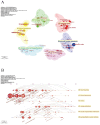Knowledge domains and hotspots of the association between hypertension and noise: a bibliometric analysis and visualization study from 2003 to 2023
- PMID: 40201787
- PMCID: PMC11975859
- DOI: 10.3389/fcvm.2025.1492051
Knowledge domains and hotspots of the association between hypertension and noise: a bibliometric analysis and visualization study from 2003 to 2023
Abstract
Objectives: Noise pollution has become an increasingly severe environmental issue in modern society and has been recognized for its adverse effects on cardiovascular diseases. Hypertension induced by noise exposure has garnered significant research interest and a large quantity of studies have been conducted. This study aims to employ bibliometric methods to comprehensively review the literature on the relationship between noise exposure and hypertension and to analyze the current state of research by identifying key areas of focus while also exploring future trends in this field.
Methods: The bibliometric analysis was conducted using the Web of Science Core Collection (WoSCC) database. The search query included terms related to noise pollution and hypertension. The timeframe for the search was from 2003 to 2023. Data analysis and visualization were performed using VOSviewer, CiteSpace, Scimago Graphica, and Rtools, focusing on publication trends, citation metrics, explosive intensity, and collaborative networks. Pajek was used to adjust pictures.
Results: The bibliometric analysis showed a notable rise in research output on the relationship between noise pollution and hypertension. The United States led in the number of publications, with China and Germany coming next. The study identified several key contributors, with Muenzel Thomas being the most prolific author, followed by Daiber Andreas and Pershagen Goran. Institutionally, Johannes Gutenberg University Mainz emerged as the leading institution in terms of publications, followed by Karolinska Institute. Collaborative networks among institutions highlighted significant international cooperation, with extensive collaborations observed, particularly between European and North American institutions. The study also pinpointed research hotspots and emerging trends through keyword analysis. Key areas of focus included the mechanisms linking noise exposure to hypertension, the impact of noise on cardiovascular health, and the role of environmental stressors.
Conclusions: This study advances our understanding of noise-induced hypertension's physiological and biological mechanisms, emphasizing the need for continued research. The research underscores the necessity of addressing noise pollution as a significant public health concern.
Keywords: CiteSpace; VOSviewer; bibliometrics; hypertension; noise.
© 2025 Wu, Zhang, Zhang, Pu, Liu, Yuan, Chen, He, Hao and Gu.
Conflict of interest statement
The authors declare that the research was conducted in the absence of any commercial or financial relationships that could be construed as a potential conflict of interest.
Figures











Similar articles
-
Bibliometric analysis of laryngeal cancer treatment literature (2003-2023).Heliyon. 2024 Dec 16;11(1):e40832. doi: 10.1016/j.heliyon.2024.e40832. eCollection 2025 Jan 15. Heliyon. 2024. PMID: 39811326 Free PMC article. Review.
-
Trends and research foci in immunoregulatory mechanisms of allergic rhinitis: a bibliometric analysis (2014-2024).Front Immunol. 2024 Sep 24;15:1443954. doi: 10.3389/fimmu.2024.1443954. eCollection 2024. Front Immunol. 2024. PMID: 39380999 Free PMC article.
-
Development and trends in research on hypertension and atrial fibrillation: A bibliometric analysis from 2003 to 2022.Medicine (Baltimore). 2024 May 24;103(21):e38264. doi: 10.1097/MD.0000000000038264. Medicine (Baltimore). 2024. PMID: 38788040 Free PMC article.
-
Exploring research trends and hotspots on oxidative stress and bronchopulmonary dysplasia: Insights from bibliometric and visualized study.Pediatr Pulmonol. 2024 Dec;59(12):3610-3623. doi: 10.1002/ppul.27268. Epub 2024 Sep 12. Pediatr Pulmonol. 2024. PMID: 39264135
-
Navigating the Global Landscape of Exercise Interventions for Knee Osteoarthritis: Exploring Evolving Trends and Emerging Frontiers From a Bibliometric and Visualization Analysis Perspective (2011-2022).J Am Med Dir Assoc. 2024 Nov;25(11):105269. doi: 10.1016/j.jamda.2024.105269. Epub 2024 Sep 16. J Am Med Dir Assoc. 2024. PMID: 39299293 Review.
References
-
- Chen J, Hart JE, Fisher NDL, Yanosky JD, Roscoe C, James P, et al. Childhood exposure to air pollution, noise, and surrounding greenness and incident hypertension in early adulthood in a US nationwide cohort -the growing up today study (GUTS). Environ Res. (2024) 263(Pt 2):120153. 10.1016/j.envres.2024.120153 - DOI - PMC - PubMed
LinkOut - more resources
Full Text Sources

